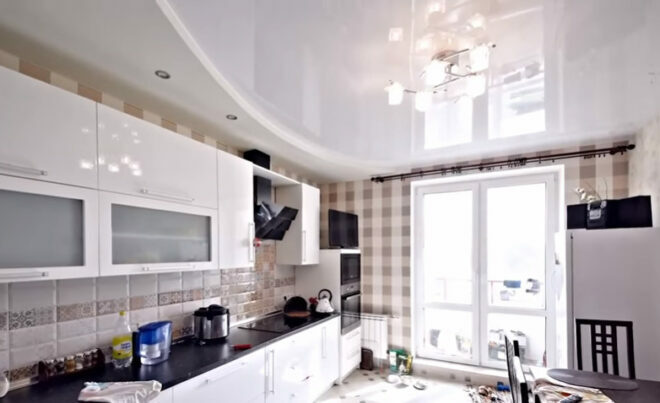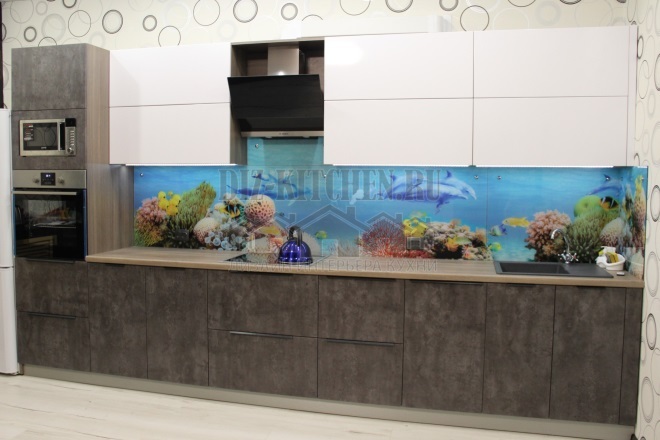- Advantages and disadvantages
- Types, facts and advice
- Kinds of lamps
- Placement of fixtures and the rules of "playing with light"
- How to mount a spotlight correctly
Advantages and disadvantages
Spot lights can supplement or completely replace the central ceiling chandelier because:
- The main plus - they allow you to make lighting in the kitchen uniform, diffuse, soft as separately, and in combination with a chandelier or LED backlight. A conventional ceiling lamp without additional lighting creates shadows and thereby visually narrows the space;
- The backlighting on LED and halogen lamps is very economical, and the installation of spotlights with the possibility of switching on parts, that is, only where you need at the moment, for example, in the work area, when you cook, significantly saves electricity;
- Turning spots and ceiling-mounted lamps can direct light to where you want, so you can advantageously beat the dignity and shortcomings of space - low ceilings visually elevated, a narrow kitchen to expand, zonirovat combined kitchen-living room, etc. How to do it below;
- In addition, one-color or colored light bulbs can be used, forming an unusual lighting design, dividing zones and placing accents.
The disadvantages of spotlights include:
- More complicated in comparison with the chandelier installation;
- The need to think over the placement of light sources on the ceiling is still at the repair stage, but the placement of spotlights built into the kitchen set at the stage of assembly;
- Not everyone likes this modern type of ceiling lighting in the kitchen, to someone it can resemble "office" lighting. But this is a big misconception, today dot lighting can be organically written even in the traditional kitchen interior as in the photo below. The main thing is to choose the right lighting design.
Types, facts and advice
- Types of spotlights for installation are divided into: mortise, overhead, suspended. If the mortise can be built only in suspended ceilings (tension, plaster, rake, etc.), then the overhead (external) lamps can be installed on a conventional concrete ceiling, because on the base of the shell of such a spot there is a special mounting plate under screws;
- Embedded models - this is the most popular type in the category of spotlights, so they are presented in a very wide color, design assortment and size range;
- The luminaires can be completely drowned in the base and then they are practically not visible, but can decorate the ceiling on the contrary, projecting over its surface with a beautiful decorative lens;
- Spotlights can create local, basic and decorative lighting;
- Each of the installed devices can illuminate no more than two square meters of the room;
- Modern appliances are fireproof, and therefore can be used in combination with any trim. And their body is made of moisture-proof material, which makes it easy to withstand high humidity;
- There are designs with an internal or external arrangement of the bulb, which provides directional or diffuse light, respectively.
Advice:
- The simpler the design of the spots, the easier it is to take care of them - wash out fat deposits, dust, etc .;
- For suspended ceilings, it is better to choose luminaires round or with rounded corners;
- For a more economical and rational consumption of electricity, install a dimmer, which is also called a rheostat or dimmer.
Kinds of lamps
Lamps can be: LED, halogen or incandescent.
LED lights are well-deserved popularity. They are economical and consume very little power, and they also do not heat up much. Therefore, LED devices can be used in combination with a variety of finishes - their location even next to flammable materials will not lead to a fire.
LED recessed lights are turning and non-turning. Rotary lamps allow you to change the direction of light.
Devices with installed incandescent lamps give a bright, familiar to everyone a pleasant light, but they are much more in size, so they require installation with a large margin, in addition, they have a small period service.
In terms of durability and energy efficiency, halogen lamps are beneficial, but they are also considered the most expensive. They give a bright, close to natural lighting, but have one drawback - the lamp is very strong heated, so choose lamps with a metal frame, glass diffuser and ceramic cartridge.
Keep in mind that for spotlights with halogen lamps you need a transformer that converts the usual 220 watts into the desired 12 watts. The power of the transformer should slightly exceed the total power of all halogen bulbs.
The installation of spotlights in the kitchen with tension ceilings implies a limitation on the power of the installed lamps. Thus, the power of halogen devices should not exceed 35 watts, and the power of incandescent lamps - 60 watts. This is due to the properties of the material, which can melt from too high temperatures.
Placement of fixtures and the rules of "playing with light"
To create the main lighting in the kitchen, ceiling spotlights should be placed at a distance of at least 30-40 cm from each other. A distance of at least 20 cm is maintained from the corner of the wall. Experts advise to install one point on, sq. M. m or follow the following recommendation - for each 1 sq. m. of ceiling there must be a 20-watt luminaire. If you want to install lamps with a power of more than 20 watts or plan to combine them with a chandelier, their number can be reduced.
Using the correct location of the spotlight, you easily change the whole perception of space.
Visually expand a small, narrow or extended kitchen can be, if you install a group of several lamps along the center and on two sides of the ceiling of a narrow or elongated kitchen. That is, the main goal - to maximally evenly fill the space with soft, diffused light without shadows.
In lighting large areas, the main task is to arrange the light sources so that they perfectly illuminate all the functional areas, but at the same time create a cozy, intimate and pleasant atmosphere. Most often, the fixtures are placed as in the photo below: on the perimeter of the kitchen are spots, and in the center above the table or island are hanging chandeliers.
The most versatile option for placing spotlights in the kitchen is as follows: in the kitchen center, above the table or bar stand can be hung ceiling lamps or a chandelier, and spots set only above the working area directly above the kitchen headset.
But if the kitchen has low ceilings, it is better to choose rotary models and direct their light up to the ceiling, and also install the lamps on the visor of the hanging cabinets of the kitchen set. Chandelier in a low kitchen is better not to hang.
In addition, spotlights allow you to perfectly zonate the room, highlighting each of the functional areas. Typically, in the combined spaces - in the studio apartment, kitchen-dining room, kitchen-living room, working area, kitchen area or the adjacent hallway is highlighted with a spotlight, and the rest area or the dining room is illuminated by a chandelier and hanging lamps.
Spotlights are simply designed to decorate and illuminate two-level ceilings. In this case, as a rule, embedded models are used. Highlight all or only one level as on the next photo on the right.
How to mount a spotlight correctly
The installation of spotlights requires the preparation of a certain instrument and devices:
- Terminals for connection;
- Flat-screw driver;
- Crowns for wood or metal (the latter will be required for working with a lath ceiling);
- Mounting knife for stripping wires;
- Drill;
- Nippers;
- Pliers;
- Stairs.
Connection of spotlights is not possible without creating an appropriate electrical wiring. At the first stage, a lighting box is installed - it is mounted in such a way that it is always accessible to it. This means that you should not put the box behind the plating. After this, a separate wire is laid from the box to each lamp. The wires must be placed in the corrugated tube, which is necessary for protection.
If you plan to be placed in a plasterboard ceiling, then the work is carried out in the following sequence:
- Precisely marked the location of each device on the ceiling, while you need to take into account the location of the guides, the fixtures should not be attached to them;
- The crown on the drill is cut out a hole of the appropriate size, and for square devices the hole is made by an electric jigsaw;
- The cable that has been passed before is taken through the hole. Of course, during the work the wire must be de-energized. In order to get the cable out of a small hole for sure, a wire hook is used;
- The wire pulled outwards is connected in accordance with the colors through the terminals. If you use LED lights with screw terminals for the wire, then no terminals will be required;
- Then follows the location of the luminaire in the hole, as a result of which it is fixed with special spring clips;
- The lamp is screwed into the device, and after that - a decorative ring is put on;
- Perform a system health check.
. Loading...
Read also:
- . LED lighting for the kitchen from A to Z.
- . Choose the perfect chandelier for your kitchen.
- . Fixture for the kitchen by own hands - 3 ways and ideas of design on their basis.
- . The choice of lighting under the kitchen cabinets and not only.
- . Sconce in the kitchen is a game with light according to the rules.


